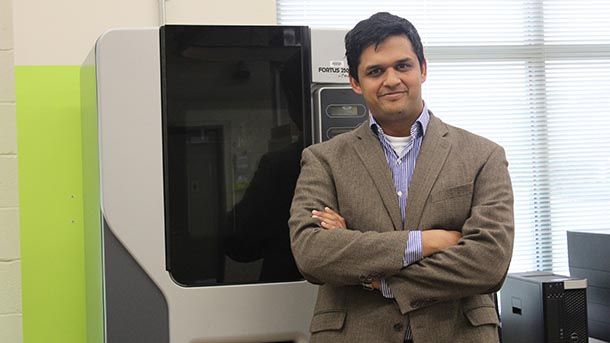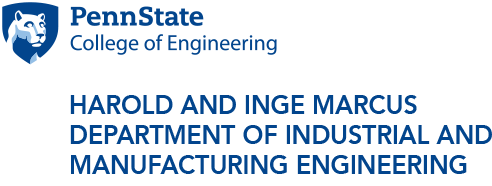
Saurabh Basu, assistant professor of industrial and manufacturing engineering, is working on making additive components more reliable thanks to a grant from the National Science Foundation.
Basu receives NSF funding to make 3D-printed parts more structurally sound
9/26/2018
UNIVERSITY PARK, Pa. — Saurabh Basu, an assistant professor of industrial and manufacturing engineering, has received more than $260,000 in funding from the National Science Foundation (NSF) to improve the reliability of 3D-printed parts that are operated under extreme stress.
“Hybrid-Compatible Deformation Processing of Performance Critical Components” is a three-year collaborative research project that focuses on bettering the structural integrity of metal parts made using additive manufacturing that are used in U.S. aerospace, defense and energy applications.
Additive manufacturing is already used by a variety of industries in a number of different applications worldwide; however, it is far from perfect or practical for a number of industries.
“Part of the reason it is challenging is because it’s a slow process and if you try to speed it up, the physics of the process kind of go out of control. You end up with defects and tiny holes that are engrained in the part you are making,” said Basu. “This project basically adds a layer of conventional plastic deformation to seal those holes up during the manufacturing process so you don’t have to go back and fix them in post-processing.”
Conventional manufacturing involves plastic deformation (such as bending, shearing or extruding) in order to change the shape of the raw materials, such as sheets of metal and cylinders, into useful required shapes, like the body of a car that is made with sheet metal. Basu explains the process as being essentially the same process as sculpting clay, with some caveats. One bends, tears and compresses clay into the shape they want; however, in this case, it is metal that is used to manufacture machines that work and can actually be used.
“In additive manufacturing, we are able to fabricate the shape we want quickly, much faster than using conventional manufacturing,” explained Basu. “Complex shapes that cannot be made by conventional manufacturing can also be made additively, even using very complex materials. But the parts are not trustworthy because of the defects. The stresses around those imperfections naturally expand and the part begins to fail or fall apart.”
The problem can be mitigated, said Basu, by intermittent plastic deformation, such as shearing, through manufacturing processes that are embedded within the additive manufacturing step to collapse the defects and thereby make components trustworthy.
To better understand how defective 3D-printed parts can be, Basu quoted published research by fellow Harold and Inge Marcus Department of Industrial and Manufacturing Engineering faculty member Hui Yang. Yang, Harold and Inge Marcus Career Associate Professor, and his team of researchers looked at additive components made at the Center for Innovative Materials Processing through Direct Digital Deposition (CIMP-3D) at Penn State. He found that out of seven components, which were built simultaneously with the same computer-aided design model in a commercial 3D printer, only two were free from defects and could be used.
Basu’s research is of particular interest for those companies, and the U.S. military, that require equipment to undergo an enormous amount of stress – whether it be part of a wind turbine for energy or an engine designed to go under water or into space.
“We have to make sure that we can better trust additive components not to fail before we regularly use them in an application, say, where a real person’s life may be lost if a part doesn’t hold up under stress,” he said. “In many situations the parts just aren’t good to use in our national security efforts because the rate of failure is just too high. We need to fix that.”
Chris Saldana, assistant professor of manufacturing at Georgia Tech, is heading the second component of the collaborative project, which the NSF has given $214,747 to support.
“This research brings the best of both worlds – additive manufacturing and traditional manufacturing – together,” said Basu. “Chris will be looking at X-ray characterization while I am working on the modeling techniques to try to make these components hold up and be more reliable.”



